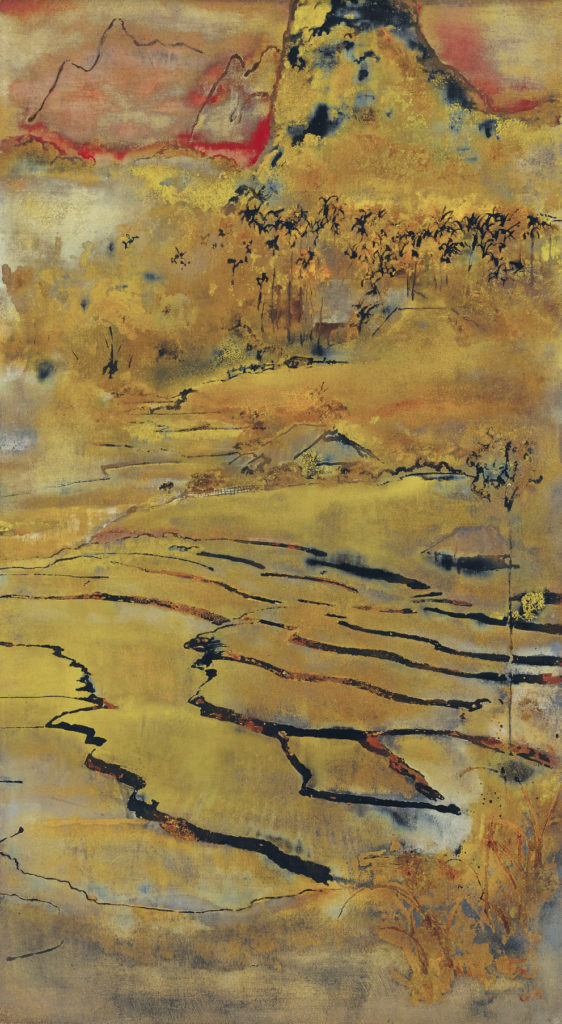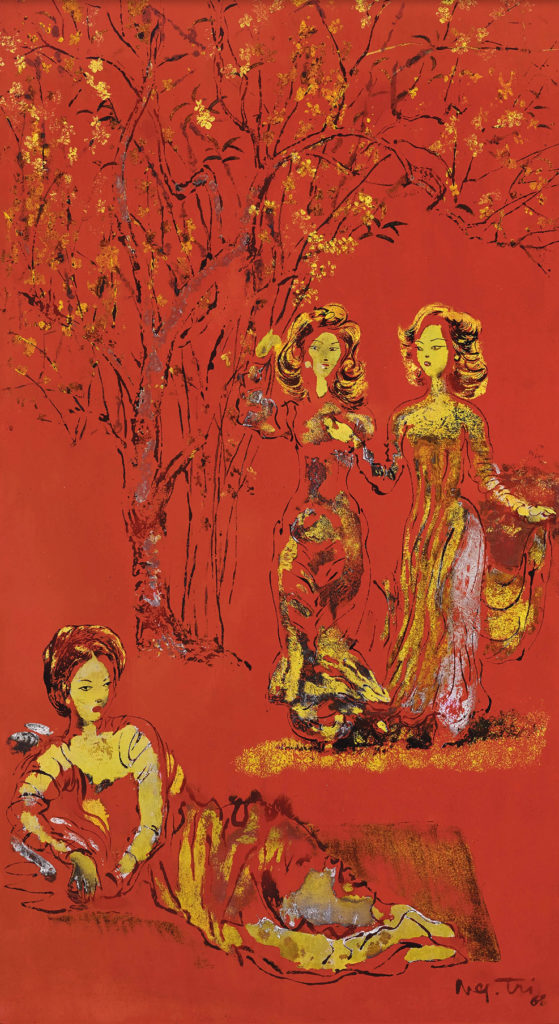« Nostalgie du Haut-Tonkin » & « Les Élégantes », 1968, two masterworks by Nguyen Gia Tri
The « Nostalgie du Haut Tonkin » (“Nostalgia for Highland Tonkin”) and « Les Élégantes » (“The Elegant”) are lacquers, an art form unique to Vietnam, by the ultimate master Nguyen Gia Trí.
Through these two major works, the great master takes us on a journey, taking on the role not only of a great artist in this field, but also of a talented theorist who embodies the artistic and political Vietnam of the 20th century.
Nguyen Gia Trí shares the elegance and beauty of his country and its inspiring history. Indeed, the artist’s own life was fully immersed in the events of his time, at times as an observer and at times an active participant, sometimes winning and often defeated, as he witnessed the many tragedies of war : the war of independence, exile in Hong Kong, the division of North and South Vietnam. Much of his work interprets the increasingly frequent political upheavals of his nation while contributing to the artistic richness of his time.
Nguyen Gia Trí was an engaged artist, a profoundly patriotic man exiled both physically and spiritually, and a genius in the art of lacquer: masterpieces are always created both from a man’s sensibilities and his talent as an artist.

In 1968, the artist created « Nostalgie du Haut Tonkin ». This sublime lacquer depicting the magnificent regions which he knew and where the homes of ethnic minorities, easily recognizable by the roof’s distinctive style, appear between the rice paddies and the sugar loaf-shaped mountains. The artist depicts the place not as a topographer or as an ethnologist but as a painter of emotion, of impressions. The mineral is transcended, the vegetation glorified. Where are we? In Sapa (Lao Cai), in Mu Cang Chai (Yen Bay) or in Hoang Su Phi (Ha Giang)? As a native of the north (born near Hanoi, Hadong in 1908), he yearns for these regions inaccessible to him since the partition of the country in 1954. No human is represented here which is rare in the painter’s work: eternal memory cannot be sullied by mortals.
In an entirely vertical composition, the artist situates the hamlet, place of the living, between the rice paddies and mountains, between heaven and earth. The artistic void of the water below reflects that of the sky above. Everything is in impermanence.
Does he think of Madame de Thanh-Quan, the great poet of the eighteenth century?
“With regret for the country, the waterhen utters its complaint;
Chanting his nostalgia, the partridge sings at the top of his voice.
I stop and contemplate the sky, the mountains, the water;
My inner thoughts are alone within me.”
Or of Cao Ba Quat (1809-1855)?
“Since we know that fate alone decides on prosperity or ruin.
Let’s not tire ourselves just to seek honors.
It is the circumstances that will bring about the rise.”
This painting is bathed in a poetic atmosphere, literally in an explosion of gold and silver, in a mix of flat and gloss effect defined by very smooth lines, which insert his subject in a kind of floating ambiance. The use of red, more discreet than in the painter’s usual compositions, compels the viewer to raise his gaze to the faraway mountains.
“Les Élégantes”, the second lacquer, is also a masterwork.

This lacquer, like the one above, was commissioned by the French collector Maurice Rossi in 1968. The work appears at first glance to be an unusual piece not perfectly in line with Nguyen Gia Trí’s body of work, but on further reflection one sees that in this lacquer, he remains very faithful to his themes.
The two ladies walking together, their Western hairstyle, almost dancing with ample gestures, is a scene far from the Vietnamese classical style usually found in Nguyen Gia Trí’s representations. Closer to this style is the lady found on the bottom left of our painting, with her posture, her hairstyle and in her expressions. One of the trees seem to be in blossom as the other appears to be in agony, perhaps sensing the impending death of Nguyen Gia Trí’s Vietnam as he knew it and as he dreamt it. That year (1968) the Têt was particularly bloody…
This painting is bathed in poetry, in an explosion of gold, cinnabar (a most noble color and the color of blood) and egg-shell. The mix of flat and gloss effect, guided by the artist’s fine brush strokes, places his subjects in a kind of floating ambiance.
Each is a unique piece of artwork, dedicated, personalized, both manifestos produced by the best lacquer artist in the history of Vietnam.
Jean-François Hubert